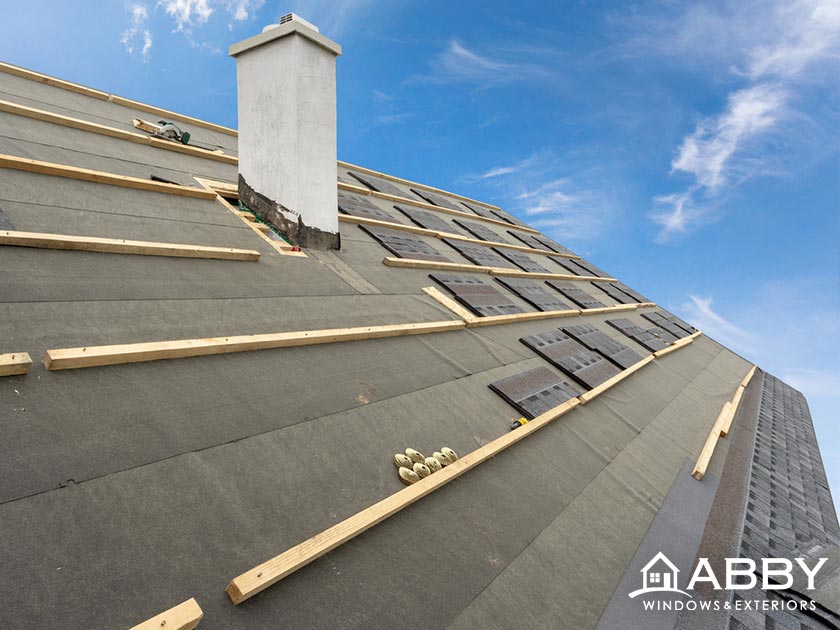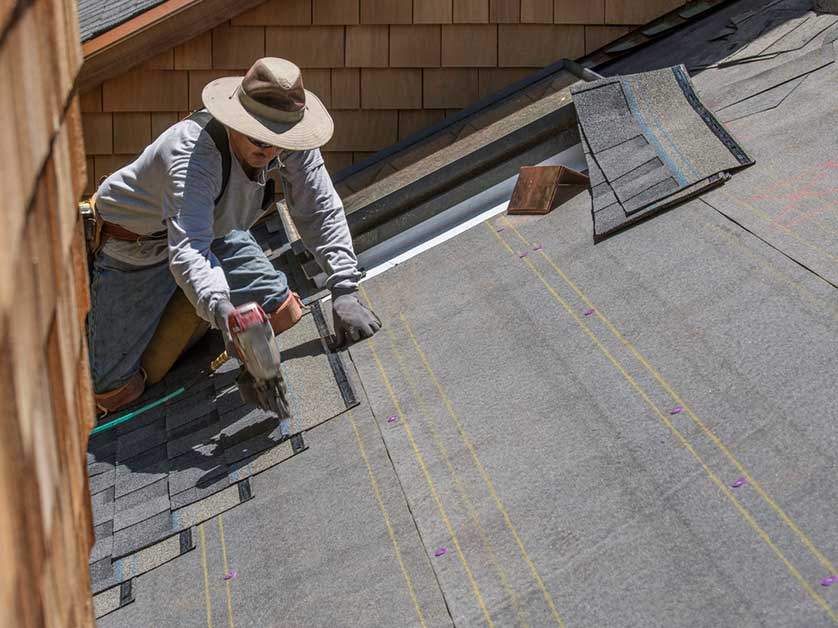Underlayment serves as a moisture barrier in roofing systems, protecting the structure from water damage. It offers an additional layer of defense beneath the primary roofing material.
Choosing the right underlayment is crucial for any roofing system. As a hidden but integral part of the roof, it’s designed to catch any water that may seep through the outer roofing layer, thereby safeguarding the roof deck from rot and deterioration.
This layer not only enhances the roof’s durability but also contributes to its overall performance and longevity. Roofing underlayment comes in various materials, including felt, rubberized asphalt, and synthetic fabrics, each catering to different climate needs and roofing types. Selecting an appropriate underlayment is a vital step in the roof installation process as it ensures your home remains secure and dry through changing weather conditions.

Credit: www.abbywindows.com
Significance Of Underlayment Protection
The underlayment of a roofing system might be out of sight, but its role should never be out of mind for homeowners and builders alike. Acting as a critical barrier, roof underlayment provides essential protection to the decking from moisture, wind, and other damaging weather conditions. Navigating through the intricacies of roofing, understanding the importance of underlayment is key to maintaining the structural integrity and efficiency of your home.
Fundamental Purposes Of Underlayment In Roofing
The core functions of roofing underlayment are multifaceted and crucial in ensuring a well-protected home. This hidden layer serves several purposes:
- Moisture Protection: It acts as a secondary barrier against water infiltration, should the outer layer be compromised.
- Weather Resistance: Underlayment provides an extra level of defense against extreme weather conditions, from high winds to hail.
- Installational Aid: It creates a smoother substrate for the roof covering, aiding in a more efficient and precise installation.
Weatherproofing And Insulation Benefits
In the battle against the elements, the weatherproofing and insulation advantages of a reliable underlayment are undeniable. It:
- Reduces the risk of ice dams and wind-driven rain that can lead to costly damage.
- Limits the transfer of cold and heat, complementing attic insulation and enhancing overall energy efficiency.
Quality underlayment materials may also reflect UV rays, thereby minimizing heat absorption and contributing to a cooler roof space.
The Impact On Roof Durability And Longevity
One of the lesser-known yet significant benefits of roof underlayment lies in its ability to extend the life span of the entire roofing system. A robust underlayment:
- Prevents shingle blow-offs by providing a better surface for shingle adhesion.
- Protects the roof deck from rot and mold, which can weaken the roof structure over time.
- Ensures that the building stays dry and secured during roof installation or repair, which might otherwise expose the roof to the elements.
Ultimately, investing in high-quality underlayment is not only cost-effective in the long-term but also increases the overall value of the property by safeguarding it against preventable deterioration.
Options And Material Variants
The integrity of a roofing system significantly depends on what lies beneath—the underlayment. This essential layer serves as a protective barrier, offering additional defense against weather elements. Today’s market presents a diverse range of underlayment options, each tailored to certain climate conditions and roofing materials. Let’s delve into the different material variants, spotlighting their unique features and applications, to guide you towards making the best choice for your roofing project.
Synthetic Versus Felt Underlayment
Determining whether to choose synthetic or felt underlayment is crucial for the longevity and protection of your roof. Synthetic underlayment, made from polymers, boasts superior durability, tear resistance, and lighter weight. It remains stable against UV exposure and can stand alone as a cover for a longer period during construction.
On the other hand, felt underlayment, commonly known as tar paper, is made from natural materials like wood cellulose saturated in asphalt. It’s a traditional choice, valued for its affordability and reliability. However, felt can absorb moisture, become heavier, and is more susceptible to tearing than its synthetic counterparts.
Rubberized Asphalt Underlayment For Extreme Conditions
When roofing in areas prone to severe weather, rubberized asphalt underlayment is the go-to option. This self-adhering rubberized asphalt sheet is designed for maximum protection. With a sticky backside that seals around nails, it offers an impermeable barrier against water.
- Self-healing properties that mitigate damage from fasteners
- Enhanced flexibility, making it suitable for low-temperature applications
- High thermal stability, retaining its integrity in extreme heat
This material is often favored for its resilience, especially in valleys, eaves, and other vulnerable areas of the roof.
Comparing Breathability And Water Resistance In Materials
Choosing the right underlayment requires a balance between breathability and water resistance. These are pivotal features that contribute to a roof’s ability to manage moisture and temperature regulation. Synthetic products provide excellent breathability, allowing moisture from inside the attic to escape, while blocking water from the outside.
Felt underlayment, albeit less breathable, does offer a degree of water resistance. Newer, high-grade felt options come with additional coatings to enhance water repellency. However, for maximum protection against rain and snow ingress, rubberized asphalt remains unparalleled in its category.
Differences in water resistance and breathability can significantly impact the roof’s performance in various climates:
| Material | Breathability | Water Resistance |
|---|---|---|
| Synthetic | High | Very High |
| Felt | Moderate | Good |
| Rubberized Asphalt | Low | Excellent |
Examine these factors closely, as the proper underlayment will uphold the life span and efficacy of your roofing system, providing peace of mind and lasting durability.
The Role Of Underlayment In Roofing Systems
The hidden hero of a robust roofing system often lies beneath the shingles or tiles that we can see – it’s the underlayment. This critical component plays a pivotal role, serving as a protective barrier that shields your home from moisture, wind, and other environmental elements. Essentially, underlayment is the unsung sentinel that extends the life of your roof by preventing water infiltration and providing an extra layer of insulation. Understanding its importance is key, but just as crucial is knowing how to correctly install this layer to ensure that your roof performs at its peak throughout its lifespan.
Before underlayment can be laid down, it’s essential to properly prepare the roofing deck to ensure a smooth application and optimal functionality.
- Inspect the decking for any signs of damage, and repair as necessary.
- Clean the surface to remove any debris or nails that may interfere with the underlayment.
- Ensure the deck is dry to avoid trapping moisture.
- Apply a drip edge along the eaves to aid in water shedding.
Laying down underlayment requires a careful approach to provide maximum protection. Here are the steps for a solid application:
- Start from the bottom edge of the roof and unroll the underlayment horizontally across the roof.
- Smooth out the material to prevent wrinkles and bubbles, which can inhibit its effectiveness.
- Trim the underlayment to fit the contours and protrusions of the roof using a roofing knife.
To achieve weather-tight seams, proper overlapping and fastening are critical:
- Overlap the underlayment sections by at least two inches, or as specified by the manufacturer.
- Use enough roofing nails or staples to secure the underlayment firmly, especially at the edges and overlaps.
- Ensure that each fastener is flush with the roofing surface to avoid punctures or tears.
Different roofing materials may require unique underlayment applications for the best performance:
| Roofing Material | Underlayment Consideration |
|---|---|
| Asphalt Shingles | Synthetic or felt underlayment can be used; consider local climate for best choice. |
| Metal Roofing | Synthetic underlayment with high-temperature resistance is preferred to mitigate heat. |
| Tile Roofing | Use heavier underlayment that can support the weight and structure of tile. |
Note: Always follow local building codes and manufacturer’s instructions for the specific type of roofing material you’re working with.
Interplay Between Underlayment And Airflow
The roof over your head does more than just protect you from the elements; it’s a complex system where each component plays a crucial role in its overall efficiency and longevity. One such component, which often doesn’t get the limelight it deserves, is the underlayment. This thin layer tucked away beneath your shingles serves a vital function, and it has a curious interplay with airflow that can significantly impact the health of your roofing system.
The importance of ventilation in roofing systemsThe Importance Of Ventilation In Roofing Systems
A well-ventilated roof is essential for the longevity of roofing materials, the comfort of your home, and energy efficiency. Ventilation helps in regulating temperature and moisture levels by allowing air to circulate freely through the attic. This circulation prevents damaging conditions such as ice dams in winter and excessive heat buildup in summer, both of which can lead to premature roof deterioration.
How underlayment affects attic temperatures and moistureHow Underlayment Affects Attic Temperatures And Moisture
Underlayment works as a secondary barrier against water and moisture, safeguarding your home from leaks and water damage. However, it also plays a part in the thermal performance of your attic. Certain types of underlayment have reflective properties that can reduce heat absorption, thus keeping attic temperatures lower. Conversely, poor underlayment choices may trap moisture, leading to mold growth and reduced insulation efficiency.
Ensuring proper ventilation with the right underlayment choiceEnsuring Proper Ventilation With The Right Underlayment Choice
Selecting the right underlayment is crucial for optimal airflow in your roofing system. Breathable underlayments allow moisture to escape from the attic, thereby reducing the risk of rot and mold. They also help to balance attic temperatures, playing a part in the overall thermal regulation of your home. When combined with proper soffit, ridge, and gable vents, the right underlayment ensures a continuous flow of air, maintaining a healthy and efficient roof.
Preserving Underlayment Integrity
The underlayment is a critical but often overlooked component of roofing systems. It acts as a protective barrier, guarding against moisture and providing an extra layer of insulation. To ensure the longevity and effectiveness of your roof, maintaining the integrity of the underlayment is vital. Let’s delve into the specifics of keeping your underlayment in top condition.
Routine Inspections And Identifying Underlayment Issues
Regular inspection of your roof’s underlayment is essential to catch potential issues before they escalate. It’s best to schedule these assessments biannually, typically in the spring and fall. A thorough check includes looking for:
- Water damage indicators, such as mold or mild spots.
- Signs of cracking or tearing, which could lead to leaks.
- Bubbling or wrinkles that suggest poor installation or ventilation issues.
Identifying these issues early can prevent extensive damage to your roof and home.
Addressing Repairs And Preventative Measures
Timely repairs can extend the life of your underlayment. If an inspection reveals any damage, immediate action is necessary. Some common repair techniques include:
- Using sealants to patch small cracks or tears.
- Reinforcing areas around roof penetrations like vents and chimneys with additional underlayment material.
- Ensuring proper attic ventilation to minimize heat and humidity buildup that can degrade underlayment.
Alongside repairs, preventative measures such as installing sufficient insulation and proper attic ventilation are worth investing in to protect the underlayment from premature wear.
Expected Lifespan And Replacement Signs For Different Underlayment Types
Different underlayment materials come with varying lifespans and warning signs when they need replacement:
| Underlayment Type | Expected Lifespan | Replacement Signs |
|---|---|---|
| Asphalt-saturated felt | Approx. 20 years | Frequent tearing, dryness or brittleness |
| Synthetic | 30 years or more | Significant uv damage, loss of waterproof integrity |
| Rubberized asphalt | Up to 35 years | Wear around roof protrusions, loss of adhesion |
Understanding the material specifics and lifespan of your underlayment helps in planning for replacements. Look for the discussed signs to ensure your underlayment continues to perform its essential function.
Frequently Asked Questions For The Role Of Underlayment In Roofing Systems
What Is Roofing Underlayment?
Roofing underlayment is a barrier material installed under shingles or other roof finishes. It provides an added layer of protection from water and weather damage, improving your roof’s durability and longevity.
Why Is Underlayment Essential For Roofs?
Underlayment acts as a secondary defense against leaks and moisture. It helps protect the roof deck from water infiltration that can cause rot and mold, particularly in the event that the outer roofing layer is compromised.
What Types Of Underlayment Are Available?
There are three main types of underlayment: asphalt-saturated felt, non-bitumen synthetic, and rubberized asphalt. They differ in durability, water resistance, and price, catering to various roofing needs.
How Does Underlayment Improve Roof Lifespan?
By preventing water intrusion, underlayment protects the roof structure from moisture-related issues. This contributes to a healthier, more resilient roof, thus extending its overall lifespan.
Conclusion
Underlayment plays a pivotal role in preserving a roofing system’s integrity. It acts as a protective barrier, shielding the roof from water damage and enhancing insulation. Ensuring the selection of quality materials and proper installation is crucial for any roofing project.
Remember, a reliable underlayment can greatly extend the life of your roof, saving time and money in the long run.

